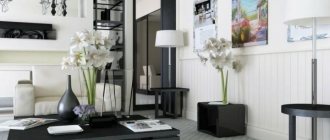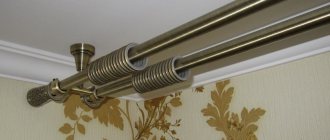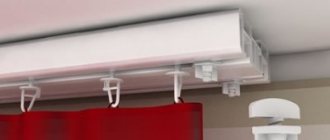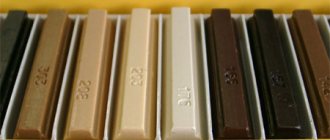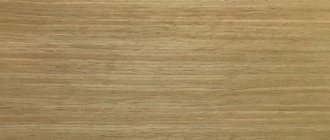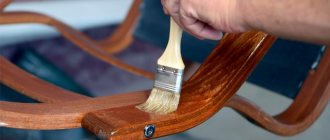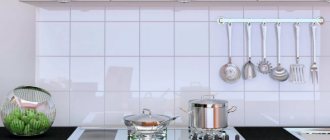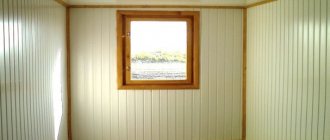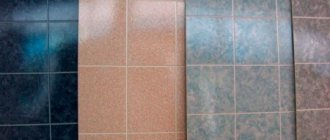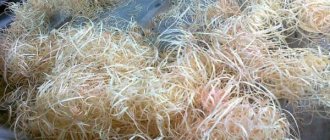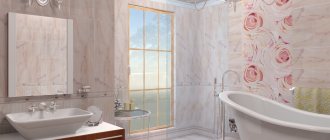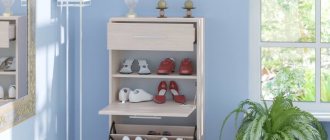Help the site, share with friends:
Today, PVC panels allow you to create a cozy interior design.
They are used in any living space, from the balcony to the attic. The variety of color palettes allows you to find absolutely any shade that will complement the interior space.
The low cost of this type of building material makes it accessible to every consumer. The appearance of such structures imitates natural wood and stone. There are textured lines on its surface.
Sizes and decor
The sizes of PVC panels vary depending on their type.
Therefore, before choosing the desired option, it would be useful to familiarize yourself with what the panels can be in size. After all, depending on this, you can choose the most optimal option for a particular interior. Dimensions of plastic lining:
- thickness – from 8 to 12 mm;
- length – from 300 to 1200 mm;
- width – from 100 to 500 mm.
Dimensions of panels for tiles:
- thickness – from 0.5 to 1 millimeter;
- length – up to 1000 millimeters;
- Width – 500-1000 mm.
Sandwich panels dimensions:
- thickness – from 10 to 32 mm;
- width – from 900 to 1,500 mm;
- length – up to 3,000 mm.
In addition to size, the panels also differ in their decorative appearance. The coating of the panels differs, which can be glossy or matte. They can be colored, patterned or even embossed. For example, lining is most often white matte or glossy; sheet panels can even imitate tiles in their appearance.
Depending on the type of coating, the panel can be matte or glossy. There are also differences depending on the application of paint to the surface of the panel. For example, a pattern is applied to a white panel, and then it is painted in colors using a special paint roller. After this, a colorless ultraviolet varnish is applied as a protective layer.
Of course, today it is completely easy to choose finishing options, even if the interior design requires something special. For example, if the interior has a marine or country theme, then panels with an imitation of cut stone would be an excellent option. PVC options with images of natural slate look amazingly realistic. This solution is especially relevant for the bathroom.
Very sophisticated and subtle options among plastic tiles are also not uncommon. You can choose blue marble models. A few suitable decorative elements, and a room with such tiles will be the height of elegance. Of course, the most common color is white or panels with a pattern. However, dark colors have also shown that they are in considerable demand.
Among those in demand are red shades, transparent panels, and imitation bamboo. Wide and thin sheets of panels look especially impressive, giving the walls the most smooth and luxurious look. It is worth noting that wood-effect panels (especially pine) have also proven to be one of the most popular.
Mirror PVC can be an amazing decoration, which instantly gives the room an attractive look. They are actually polystyrene glass that is attached to a frame. Moreover, a pattern, perforation or it will have a holographic effect can be applied to its surface.
Panda panels have an exclusive design. They have very high quality and bright designs. Moreover, the images are visible very clearly, it is not difficult to see even the smallest details. The interiors of a bathroom, hallway, kitchen or living room with such panels will be chic. After all, the collections feature one main drawing and from one to five additional ones.
Chic wenge color options would also be an excellent solution. Their rich dark brown color, approaching black, will bring a real tropical note. An instant transformation can be achieved using black and white patterns on PVC. For those who like something brighter and more luxurious, there are options in combination with a golden hue.
There are a huge variety of PVC decorative designs. It is enough just to choose a suitable variation for a specific interior.
MDF panels
Finishing wall panels based on MDF are available in three forms: slatted, slab and sheet. Their surface can be finished with veneer or laminated (covered with film), or painted. The surface can be smooth or embossed, the color can be any, even floral. Most often, MDF panels imitate a wooden surface (can be the natural color of wood, lightened, tinted in different colors).
Traditional panels can be made from slab-type MDF wall panels. This option is also not bad
In classic interiors, MDF wall panels with imitation of valuable wood species are used: few people can distinguish veneered MDF from solid wood
Color variations - wood, smoothly painted Wild stone color options
Brick, stone, plant pattern... whatever you want
Veneer can be tinted in different shades
Another popular option is brickwork; stonework is a little less common. There are also plain-colored colors and, although they are presented in even cheaper materials such as fiberboard and chipboard, they are still bought. There are reasons for this:
- MDF is one of the safest materials. It is formed from wood waste ground into fibers and then pressed at high temperature. Under these conditions, a natural binder is released - lignin, which is contained in wood fibers. If there is not enough binder, add a binder previously isolated from other rocks. Therefore, MDF is considered a natural finishing material, it is approved for use in children's and medical institutions (the formaldehyde emission coefficient of this material is not higher than E1).
- MDF is not afraid of high humidity and reacts little to temperature changes. Therefore, MDF wall panels for interior decoration can be used in rooms with high humidity, but not where there is direct contact with water.
- You can create a relief of any complexity. Simpler designs are formed during pressing, while more voluminous and complex ones are formed using a milling cutter. This technology is used to make 3D MDF wall panels.
MDF wall panels with 3D effect - stylish The pattern can be any... floral, geometric, fantasy
The drawing can be like this If you also add metallic paint...
Accent wall made of volumetric MDF panels for wall decoration There are even carved ones Several options with 3D MDF wall panels
This material still has a drawback: it costs a lot. The price depends on several factors:
- Densities.
- Material thickness.
- Difficulty in forming and painting.
The minimum price is from $30 per square meter, the maximum is up to several hundred dollars. But here you also need to understand that MDF wall panels have different purposes. Available for wall decoration. They have greater density and thickness (from 8 mm thick). Minimum price from $40. For finishing the ceiling. You can take thin ones (from 6 mm), since there is practically no mechanical load. But we must take into account the following fact: the thinner the MDF, the more often it is necessary to install hangers (fasteners). Otherwise, MDF panels may bend under their own weight. Fasteners cost money, so if you can save money, it will be insignificant. But you will spend more time on work.
Chipboard wall panels
Chipboard panels for wall decoration are made of sheet and slab types. The material is characterized by low resistance to humidity, so it is used exclusively in rooms with normal humidity. It also reacts poorly to cold, which is why it is not used on unheated loggias and balconies, bathhouses, and summer cottages.
Laminated or veneered wall panels for interior decoration made from chipboard look good in modern interiors
In the manufacture of chipboards, an artificial binder containing formaldehyde is used. In high concentrations, this substance is dangerous, because the production of the material is controlled by the sanitary and epidemiological station. Each batch of material is tested, and based on the results of laboratory tests, a hygienic certificate is issued with the emission class indicated in it. An excellent indicator is Super E and E1 (like natural wood), acceptable - E2. It is better not to use anything higher (more numbers) at home.
Chipboard wall panels for interior decoration are available laminated (coated with film) or veneered. Their range is not so wide - the material is weakly plastic, so the slabs are mostly smooth. Only some manufacturers have modern equipment that allows them to shape the relief. But, even with new equipment, the maximum that can be formed is imitation of brickwork, ceramic tiles, wood texture.
In this option, you can also use chipboard wall panels with veneer
Fastening can be secret - using clamps - or self-tapping screws. When fastening with self-tapping screws, holes of a smaller diameter are pre-drilled in the material. And we must remember that it will not be possible to reinstall the same fasteners. It is necessary to use a larger diameter, since the material crushes/crumbs and is not restored.
Gypsum panels for wall decoration
About 5 years ago, gypsum wall panels for interior decoration appeared on the market. This is an environmentally friendly finishing material, absolutely faithless and hypoallergenic. Another advantage is its absolute non-flammability. It is as flammable as stones. Overall a good choice.
This is how 3D gypsum wall panels for interior decoration are sold
Production technology makes it possible to create a relief of any complexity, so such slabs have a figured front surface. They are also called 3D wall slabs. The types of relief are very different. Geometric patterns of varying complexity, curved lines, circles, plant motifs and all this in combination. There are very, very many options and variations. Production technology has almost no limitations. And all this variety is available in two versions:
- Made from pure gypsum diluted with water. Can only be used in rooms with normal humidity, since gypsum is hygroscopic. When wet, it collapses. Area of application: corridors, living quarters.
- Moisture resistant with hydrophobic additives. Additives reduce absorbency so much that this type of finish can be used in rooms with high humidity. With some types of additives, they can be installed in places of direct contact with water - near bathtubs, washstands. They can be installed in bathrooms or as kitchen splashbacks.
In any case - moisture resistant or not - gypsum wall boards for interior decoration can be painted. This is perhaps the only option for painting. The paint can be anything. Its type is selected according to the task: if wet cleaning is expected, the paint must be wash-resistant; if plaster panels mounted on the walls of the pool are to be painted, paint with a water-resistant effect is needed (or coated with varnish).
3 D plaster panels in the interior of the dining room, living room - just what the doctor ordered... Longitudinal or horizontal arrangement - you choose yourself, square slabs 50*50 cm, as you turn, so it will be
Painting and lighting are the secret to a bright interior
gypsum wall panels suitable for floor painting
One of the most perfect imitations of masonry is in plaster panels. If you paint a geometric pattern with paint with a metallic effect, choose the right lighting, the interior will be unforgettable. Geometric abstraction is suitable for any room
Volumetric figures on 3D wall panels
You can find an unobtrusive pattern in the bedroom
Installation of gypsum boards for wall finishing - with glue. If the surface is flat, you can directly on the wall; if there are differences, you need to either level the wall or install a sheathing. Use universal glue, but make sure it is suitable for the materials used and can withstand sufficient load. One slab weighs about 2-4 kg. Not too much, but not a lot.
The seams between the plates can be left, or a seamless surface can be made. The choice depends on the type of terrain and type of room. There are slabs that are clearly “square”, so the seams look attractive. You just need to take into account that it is better not to do them in the bathroom or kitchen - it will cause unnecessary problems when cleaning. There are no such problems in living rooms - there is no severe pollution here.
Bamboo trim panels
A not very common, but interesting option is bamboo wall panels for interior decoration. They are made from bamboo cut into strips which are then woven into slabs of different sizes. After which the material is pressed, painted and varnished. Such bamboo panels are suitable for interiors in ethnic style, and more so in an oriental style. The resulting braid has different thicknesses - from 1 mm to 7 mm. Depending on the thickness, bamboo panels are glued to the ceiling (1-3 mm thick) or walls (4 mm and thicker).
Several types of wicker bamboo wall panels Bamboo wickers go well with wood Different textures and weaves
The room may have an oriental style
Bamboo wall panels for interior decoration In combination with bamboo wallpaper Bamboo and cork also look organically side by side
There is another technology for producing bamboo wall panels. In this case, the stems are crushed to fibers and pressed at high temperatures. This is how 3D eco-friendly panels are made from bamboo. The same technology is used to produce similar material from cellulose and reed. The variety of patterns here is no less than in gypsum analogues, and the thermal conductivity is slightly less. The disadvantage is that they do not belong to the category of non-combustible materials. And one more thing: they are produced in China, Thailand, but there is no production in Russia yet.
Eco-friendly 3D panels for interior decoration made of bamboo cannot be distinguished from plaster in appearance. Drawings may be different.
Color matters too
The method of installing these volumetric finishing panels is with glue. The seams are puttied and leveled. The surface can be painted, but it must first be coated with a primer - to reduce and equalize the absorbency and so that the paint goes on more evenly. It is better to apply paint from a sprayer - it is difficult to paint the relief with a brush and completely impossible with a roller.
Metal panels for interior decoration
Wall panels for interior decoration are not used very often. We don’t associate metal, its shine with the comfort of home. Occasionally they can be seen in interiors in high-tech, loft, minimalism, art deco styles. As a rule, they are used to decorate an accent wall. In the most avant-garde interiors, metal wall panels can be seen on the ceiling.
High-tech uses polished or matte stainless steel, loft and art deco can use painted or artificially “rusted” black steel. Steel plates, but painted grey, black, red, can be minimalist.
Due to their resistance to water and moisture, stainless steel panels can be seen as kitchen cabinets.
For the daring ones - finishing the walls in the bedroom with steel wall panels
Aged copper is an excellent finishing material for Art Nouveau, loft style
Steel wall panels for interior decoration can also be different Copper decorative panels for interior living room interiors Most often, steel wall panels can be seen in the kitchen on the work wall
In combination with tiles
Another option for metal panels for a kitchen splashback. For a study or office, perforated plates made of painted galvanized steel are suitable. What kind of metal finishing panels can be used for rooms?
artuk. In general, this is a good option for finishing balconies and loggias. There are metal panels coated with a layer of colored polymer. They are used for exterior decoration of buildings, so they are not afraid of anything on unheated balconies. By the way, there are corrugated metal panels that are perfect for a suspended ceiling in wet rooms (bathroom, swimming pool) and will not interfere with ventilation.
Glass and mirror
Wall panels for interior decoration made of glass and mirrors appeared several years ago. As a rule, they are mounted on previously painted surfaces, protecting them from moisture. This technique works well in rooms with high humidity - bathrooms, kitchens. Tempered glass is used, consisting of several layers bonded together with a transparent polymer. Similar glasses are used as entrance doors. So they are safe as wall decoration.
If the painted walls in the bathroom are covered with glass panels, such finishing will not be demolished
With photo printing Not many interiors use glass wall panels for indoors
Mirrors are a great way to make your interior unusual
The reflection on the glass breaks up the space. Patterned glass on a smoothly painted wall gives an interesting result.
There are also new trends - photo printing on glass. Using new technologies, any design or even a photograph can be applied to glass. Since such decorative panels still remain translucent, the wall must be painted. But the choice of color and tone depends on the desired effect.
Another non-standard type of wall panels is made from mirrors. They are also made from durable, film-glued sheets. Making a wall completely mirror is not always a good solution, but making stripes - vertical or horizontal - is an interesting idea. The interior immediately becomes fashionable and dynamic.
Examples in the interior
Numerous room design samples allow you to quickly select the most suitable option. Today it is easy to find interesting options that will suit both the Provence style and the loft style. Very original design ideas can be realized using panels with photo printing.
The design of the hallway of a room with panels will be very interesting and bright. Moreover, you can choose bright PVC sheets with floral or abstract patterns that will look great against the background of wooden furniture. An excellent option for a spacious corridor would be panels with a picture, shaded with a not too catchy pattern. In this case, it is best to give preference to bright and rich shades to make the space seem lighter and more welcoming. For those who value elegance and modesty, wood-look panels will be an indispensable option for decorating the hallway.
It’s even easier to choose an interesting interior for the bathroom. Panels with a pattern similar to small mosaics or marble look ideal. They fill the bathroom space with a special charm. And you can give them a little pretentiousness by using moldings with gold and silver elements. Panels with 3D images of a marine theme can transform a familiar bathroom into a tropical oasis.
A kitchen area finished with cladding panels can look bright, practical and modern at the same time. For the main part of the walls (preferably the top), it is better to choose a color that is not too flashy, but the smaller part can be lined with panels with a bright pattern. In this case, the working part can be highlighted in a different color, conditionally dividing the kitchen into a zone. As for the choice of colors and shades, everything is entirely individual.
For more information about decorative PVC panels, see the following video.
With thermal transfer or thermal printing
The manufacturing principle is to form a pattern or image on a polymer film and then apply temperature to transfer the pattern to a plastic panel. Actions are performed on special equipment. The process is called thermal transfer. The products have gained popularity due to their increased resistance to high temperatures and the thermal effects of steam, heat and direct sunlight. Assembling the system will not cause difficulties even for beginners. The dimensions of the material are given to standard values: 250 mm for width, 8-10 mm for thickness, 2.7, 3 or 6 m for length. Thermal printing makes it possible to apply highly complex designs on PVC panels in almost any color and shade. The technology works thanks to high temperatures and accurate calculations. The thickness is traditionally 8 mm, and the full parameters are, respectively, 300 × 25 × 0.8 or 270 × 25 × 0.8 cm.
Advantages and disadvantages
This material has become so popular due to its many advantages.
- Versatility. Typically, PVC panels are used as finishing for walls and ceilings. This material can be used to trim the edges of doors and windows, used in showers and bathtubs, and also under steps to create interesting shapes. Summer residents use this building material to form garden beds.
- Installation is quick and easy. Ordinary homeowners can now decorate a wall or any other surface. The work is done quickly and easily with smooth walls or ceilings. In such situations, they are secured with “liquid nails.” To make curved surfaces smoother, you should use a metal or wooden frame.
- Easy to care for. PVC panels can be wiped with a regular soapy rag, but you should be careful at the joints of the panels, because these areas are weak.
- Such panels are absolutely environmentally friendly. This material is non-toxic and does not release harmful substances into the environment.
- Strength. This indicator depends on the right choice. For ceilings, this material is a little lighter.
- There is sound and heat insulation. These panels create good sound insulation and do not let cold into the room.
- A large number of colors and shades. The standard color of PVC is white, but manufacturers have created a huge number of colors to suit every consumer’s taste. At the moment, panels with patterns or imitation of the texture of stone or wood are popular.
- Moisture resistance. Thanks to their smooth surface, they do not retain moisture. Since the material has no pores, dirt, mold and other harmful microorganisms do not linger on its surface. Therefore, they are often used in rooms where there is high humidity.
- Resistant to sudden temperature changes. Plastic panels can withstand temperatures from -50 to +50 degrees Celsius.
Just like other building materials, PVC panels also have disadvantages.
- Instability to ultraviolet rays. After a certain period of time, white plastic panels may turn yellow and lose their original appearance.
- Instability to impacts. Such panels can withstand some loads, but they are not protected from dents or scratches on the surface of the material.
- The material contains chalk, which is a determining component of the strength of the product. The amount of chalk in the panels is determined solely by the manufacturer.
- Characteristic smell. When purchasing and using the panels, a specific smell is present for several days, but then it completely disappears.
- This plastic cannot be called absolutely safe, as many manufacturers claim. It should not be used to decorate children's rooms.
Installation technology
As already noted, installation of PVC panels is so simple that you can do it yourself. To get started, you should stock up on the necessary tools:
- Screwdriver.
- An ordinary hacksaw.
- Scissors.
- Stationery knife.
- Roulette.
- Level.
- Square.
- Pencil.
In addition to the tool, you will need mounting elements :
- Self-tapping screws.
- Mounting profile. It is better to purchase a special one, but you can get by with a universal one - metal or wood.
Preparatory stage
Preparing the walls:
- We get rid of the old finish.
- Level the base. If the house is old and leveling to the required quality is difficult, then the defects can be corrected by lathing. This wastes a little space, but improperly secured panels can quickly become deformed and lose their appearance.
- The surface of the wall must be treated with an antiseptic. This will prevent the appearance of insects and fungus.
The position of the mounting frame is marked on the prepared wall. This work must be done carefully and always using a level. The frame begins to be mounted from below, rising to the ceiling. The lifting step is usually 500 mm.
Properties and characteristics
PVC panels contain polyvinyl chloride, which is a lightweight and high-quality material. Due to this, the ceilings in rooms, offices and supermarkets are often covered with these panels. Also, interesting patterns are depicted on PVC panels using lamination, thermal printing and other modern technologies. After this, a matte or glossy varnish is applied to this material, which protects the material.
Thanks to this treatment, the panel does not wear out quickly and is very resistant to ultraviolet rays, as well as to any damage, for example, it is protected from scratches. For the safety of human health and his family, no harmful chemical components are used in the production of such polyvinyl chloride panels. Also, when painting surfaces, only water-based paints are used, which is also absolutely safe.
There is a difference between the plastic panels used on walls and ceilings. It lies in the fact that wall-mounted options are a little stronger, and they are also not flexible, so such panels can withstand heavy mechanical loads. Also, the options for walls are thicker than for ceilings. The more polyvinyl chloride, the thicker the panel. The stiffening ribs located inside the PVC wall panels are 1 mm thick, so cutting them with a knife will not be so easy.
The length of this material is 3 meters, the width is only 10 cm, and sometimes it can reach up to 12.5 cm. Plastic lining can be used for both external and internal treatment of premises. In total, two types of this material have become popular on the market. These are “Polka” and “European”. The “polka” has a small locking connection, while the “European” has a much wider one.
External PVC panels have a seam. This is due to the fact that the material has a high coefficient of linear expansion. Therefore, the lining, which was not installed indoors, must change due to changes in temperature conditions. There is also another feature of façade lining. It lies in the fact that the coloring of raw materials in various colors occurs during production, and is not applied on top as in other types. Because of this, the lining retains its original color longer.
Sheet panels consisting of plastic are wider than those of plastic lining. Their length ranges from 105 to 405 cm. These panels are the most famous and consumed. Sometimes the surface of the sheets is sent for special treatment, but not everyone does this, but only some good manufacturers. Thanks to this operation, the panels become stronger and more stable.
Sheet panels can be mounted using glue and nails. The cracks can be sealed with a sealant of the appropriate color or with a narrow lath. Conventional panels have a length of 260 and 270 cm, sometimes even 300 cm, and a width of about 25 cm. But you can also use panels with a width of 50 cm for finishing rooms. The varnished and painted side of the outer surface also forms a seam, which is not very noticeable when it takes on a assembled appearance.
There are also GOST sandwich PVC panels, which are modern and have high performance. The peculiarity of these panels is the presence of two sheets of plastic. Polyurethane foam or expanded polystyrene foam are used as various added substances; they give the material thermal insulation properties. The degree of flammability of products is indicated on the packaging. Plastic lining has the highest coefficient.
Accessories for installation
In addition to wall panels, various additional elements or moldings are almost always used during installation. As a rule, they are made from the same material as the main product and serve for ease of installation, as well as additional finishing of the room:
- To decorate joints, external and internal corners are used. Typical size 3000*10 or 3000*8 mm.
- Various auxiliary L, F and H-shaped profiles serve for ease of installation on complex room surfaces.
- A fillet is attached at the junction between the panel and the ceiling.
- The sheathing is used for ease of installation. It is especially convenient if the walls to be decorated have not been leveled beforehand. Unlike other types of material, such products are not afraid of temperature changes and moisture.
Varieties and applications
At the moment, three types of PVC panels have gained popularity in the building materials market.
- Rack and pinion. To attach this type of panel directly to the wall surface, you must use a metal bracket. This panel has a length from 1 to 12.5 meters, a width from 15 to 30 centimeters, and a thickness of no more than 1 centimeter. If you use this type to decorate a room, it will visually look higher or lower, depending on the position of the panels themselves.
- Under the tiles. The size of this species can range from 30 cm to 1 meter. The method for finishing a room is the same as for slatted panels, but differs in its result. Such PVC panels can be laid out in an interesting pattern in the bathroom or kitchen.
- Leafy. These panels are recognized as the best of all the above types. To install this material on walls or ceilings, you will need glue and nails. The thickness of the sheet panels ranges from 3 to 6 millimeters.
PVC panels can also be divided according to their decorative properties.
- Seamless. Such panels are very popular and look expensive. Seamless panels with a matte surface look great. They are available for both flooring and furniture.
- Embossed. They look exactly the same as wooden ones, but their price is much lower. Moreover, they can be used even if the walls have some curvature. Embossed laminated panels offer a very accurate imitation of textures.
There are also several types of panels depending on the design.
Single color. They are ideal for finishing rooms where practicality and minimalism are valued. To add originality and beauty to a single-color solution, you can make multi-colored shelves yourself or use paintings.
With an image
Such panels often imitate the appearance of stone or fabric, but there are also those that attract attention with a spectacular print, for example, clouds. But difficulties may arise when installing them, since it will be necessary to accurately calculate their position, then the drawing will turn out to be seamless.
PVC panels are used in bathrooms, showers, and kitchens; they are also often used for finishing offices, restaurants, supermarkets, schools, gyms, hospitals and other premises.
Pros and cons of PVC
The use of plastic in the interior is gradually being reduced to a minimum. Due to the trend towards environmental friendliness, any non-natural materials are losing popularity. It is generally accepted that plastic finishing is a relic of the past and is only suitable in cases where you need to save money. But this finish also has its advantages.
pros
- First of all, the price - on average, PVC is 2-3 times cheaper than tiles and even wallpaper.
- Installation takes minimal time. Whereas laying a tiled apron, taking into account the preparatory work, takes a day or more.
- Manufacturers promise durability. With proper care, this cladding will last for decades.
- Moisture resistance and ease of care are another plus. There are no pores on the surface of the smooth material, so you don’t have to worry about the spread of mold, and you can easily clean it of dust and dirt with a regular damp cloth.
- This cladding has good sound and heat insulation properties. You can use it to decorate a cold “street” wall or a wall adjacent to noisy neighbors.
- Fire safety. Polyvinyl chloride is a self-extinguishing material; as soon as it lights up, it immediately goes out.
7 photos Instagram @mamochka_kate
Instagram @mamochka_kate
ShutterStock
Pixabay
Unsplash
Unsplash
Instagram @nomadhomebykim
Minuses
- Such a low cost at the same time suggests poor quality.
- Polyvinyl chloride is non-toxic, but, like any plastic, it is not a completely environmentally friendly material, since its decomposition period takes hundreds of years.
- High degree of deformability. Plastic cladding is easily susceptible to mechanical damage: impacts, cuts.
- This material does not burn, but at high temperatures it melts, which is also bad, especially when it comes to finishing the cooking area.
- Manufacturers guarantee wear resistance, but bright colors and designs fade over time and lose their original appearance.
- It will not be easy to create a current design with such a finish.
- Kitchen
How to attach a wall panel in the kitchen: instructions, tips and videos
Installation of PVC panels on the ceiling
Once the frame is installed, you can begin installing the panels themselves. You need to start work from the outermost strip; it is attached to the corner, to the transverse material using self-tapping screws. So, the next panel will be installed in the groove of the previous one. This procedure should continue until the opposite wall is completely processed.
If necessary, the last panel can be cut, but only when it is not the right size. Since the material is fragile, it is prone to scratches, cracks or dents. Therefore, when working with panels, you should not press hard. It is recommended to take a utility knife and can also be used to move the panels in the desired direction.
After the last panel has been attached, you can begin installing the baseboard. It is secured using “liquid nails,” which are applied to the interior and attached to the ceiling. Afterwards you need to hold them for 10 seconds, and carefully remove the excess glue. “Liquid nails” dry quite quickly, so excess substances should be removed from the surface quickly.
Calculation of the required material
Wall and ceiling panels have standardized parameters. For the first option, the following indicators are provided: length - 2.5-6 m, width - 250-300 mm, thickness - 6-12 mm. Narrow elements are easier to assemble. Ceiling strips have the following parameters: length - up to 10 m, width - 125-380 mm, thickness - 3-5 mm. The ceiling version may be smaller than the wall version, because the load on the ceiling is always less. Calculating the amount of material begins with measuring the perimeter of the base for the sheathing. The perimeter of windows and doors is subtracted from the result, and the resulting indicator is divided by the perimeter of one panel. Calculations are translated into determining area. The opposite sides of the room are summed up and multiplied by the height. The area of windows and doors is calculated only in one plane, multiplying the height by the width. The difference between the results obtained is divided by the area of one panel.
Calculating the material will not be difficult, but planning the original configuration will require special calculations.
Wall treatment
Owners of houses or apartments can quickly make the interior of a bathroom or toilet practical and cozy, and all this thanks to PVC wall panels. They are very easy to wash and will last for many years. Wall installation is very similar to ceiling installation.
A frame is also installed on the wall, which has already been treated with antimicrobial agents. It can be plastic or metal. This is at the discretion of the user. The first panel is inserted together with the corner into the profile, followed by other products. They are fixed on metal guides. To do this, use a claymore. The last panel is glued into a U-shaped corner. After this procedure, you can begin installing the corners and making slopes. Dismantling is carried out in a similar sequence.
When the panels are installed, you need to cut a hole where the locations for switches and sockets were previously marked. Such places are difficult to clean and paint. The panel can be made in the form of a panel and various crafts can be hung on it.
Tiled
This option is used not only in technical rooms such as the bathroom and kitchen. Tile panels of large sizes and non-standard shapes are purchased for the living room. Bathroom decoration most often consists of simple square products. In large bathrooms, the parameters reach 1x1 m - on the walls and ceiling. Modular options with many tenon joints are placed on the floor. It is better to clad small bathrooms with 10x10 cm panels with inclusions in the form of textural elements. Compositions in the form of mosaics are attached to the surface due to the connection between the elements and glue. Meter samples are often placed in kitchens, corridors, and terraces. The undeniable advantage of plastic lies in its external diversity. It is much easier to give this material an unusual shape than ceramics. As a result, any combination of ornaments, textures and colors become available.
Properties and characteristics
To understand what PVC panels are, you should first find out what these three letters hide behind them. In fact, everything is extremely simple - they stand for polyvinyl chloride (organic polymer). This is a type of plastic with its own advantages and disadvantages.
This polymer material is used for finishing, and it is worth noting that recently it has clearly become very popular. The composition of polyvinyl chloride includes chlorine (57%), carbon (42%), hydrogen with impurities (about 1%). It is very rare, but still occurs, that lead is added to PVC as a stabilizer. Of course, because of this component, rumors arose that the panels are harmful to health. However, today lead is replaced by zinc and calcium in equal parts, and therefore they are completely harmless.
PVC panels are produced in standard sizes according to GOST. Thus, the length of the panels is 2700, 3000 and 6000 millimeters, and the width is 100, 250 and 375 millimeters. As for thickness, it depends on the manufacturer and model, and its value varies from 1 to 30 millimeters.
PVC can be used at temperatures from -50 to +60 degrees. Moreover, it is advisable to use the panels for interior decoration. This is due to the fact that the temperature difference in the rooms during the day is not too strong. Of course, there are types of panels, for example for finishing a balcony, that are resistant to extreme cold or sunlight. In addition, they calmly tolerate temperature changes.
The strength of the panels depends on the percentage of polyvinyl chloride they contain. The strength is also affected by the number of stiffeners. Moreover, the ribs should not be visible through the front side of the panel.
The colors and textures of PVC panels are completely unlimited. Today you can find both white classics and wood or stone styles, and you can get absolutely any shade to order. It is worth noting that when painting this finishing material, water-based paints are used.
The surface of the panels can be either matte or glossy. The manufacturing technology is the same - varnishing; after glossing, the panels simply undergo additional processing. This coating not only has a decorative function, but also a protective one. After this treatment, the material becomes antistatic, wear-resistant, resistant to mechanical damage (scratches), and also better tolerates ultraviolet radiation.
Polyvinyl chloride lining is used for finishing walls and ceilings in residential premises, offices, and shopping malls. Moreover, in apartments they can be used everywhere, including the hallway, bathroom, kitchen, and living rooms. Of course, most often they are still used in the bathroom and kitchen. The panels are also used for finishing slopes on windows, as well as loggias and balconies.
Such extensive use of this finishing material is primarily due to the fact that it is easy to care for and even easier to install. The light weight allows you to decorate both walls and ceiling with such panels even alone. Moreover, they are sold in very convenient packaging, which greatly facilitates their transportation.
Another important property of PVC panels is that they have a low degree of flammability. This allows them to be used without undue embarrassment, in particular in the kitchen, even next to a gas stove
Wall
Options for the wall with any form factor have a thickness from 6-8 to 12 mm. Seamless modifications have a length of 2.6, 2.7 or 3 m and a width of 15-50 cm. The length of standard panels is represented in a wide range - from one and a half to three meters. The longest options are purchased for offices. 6- and even 10-meter slats are made to order. Standardization applies to wall panels. In addition to unusual options, there are nine standard sizes on sale. For a width of 100 mm, there are length options of 2.7 and 3 m. The indicator of 175 mm corresponds to a 3-meter length. The 238 mm version comes with a length of 2.6 m. Panels with a width of 250 mm are 2.7 or 3 meters long. Products of 375 mm have the same compliance. Three-meter panels also come in increased width: 400 or 500 mm. Standard dimensions are also a width of 1035 mm with a length of 0.5 m, and 1220 mm with a length of 2.44 m.
Criterias of choice
When purchasing PVC panels, you should pay attention to the cost of the product. The higher the price, the better the product
In order not to make a mistake in your choice and not to be deceived, it is worth familiarizing yourself with some aspects of the purchase.
The thickness of the panel is required. The universal thickness of vinyl for walls should not exceed 10 mm, and if you need to choose a building material for the ceiling, then you should pay attention to a thinner one. Front surface strength
This is important and necessary so that the building material can withstand damage and impacts, and at the same time there are no dents or scratches left on it. If stiffening ribs are visible from the outside, then it is better not to use such panels for lining walls. It is better to use them for ceilings, but such work will not look very good or of high quality. Number of ribs, their position and stiffness
The rigidity of a building material greatly depends on the number of ribs. The largest distance that can be between them should not exceed 10 mm.
- The uniformity of the paint covering the surface of the material indicates how the paint was applied to the panel. Most manufacturers coat the surface from the front side rather than adding color to the resin composition. This is bad because while working with the material, the paint can easily peel off the surface. Also, due to such a PVC coating, the panel may burn out, and the paint will be unevenly distributed, which is another disadvantage of such work by the manufacturer.
- When purchasing building material in a store, you need to inquire about its weight. This can help determine the stiffness of the ribs and the wall thickness of the material. The optimal weight of PVC panels should be 1.1–1.5 kg/sq.m. m.
- Are the panels firmly connected? It is better to check the strength of the connection of PVC panels when considering the product.
- What percentage of chalk does the material contain? Many professionals claim that the percentage of chalk in a product should not exceed 20%. If this percentage is higher, then there is a high probability that this material is quite fragile. Chalk is very accessible and not expensive, so some manufacturers, in order to reduce the cost of their products, add more of it than required by regulations. By bending the corner of the product, you can check the amount of chalk in it. If there is no white stripe left on the plastic, then the panel contains the required amount of chalk.
- Panels containing toxins. There is nothing wrong if the sealed lining has a characteristic, but not too pungent odor. But if a specific smell comes from the panels that are displayed as a sample, then it immediately becomes clear that this material contains toxic substances and it is better not to purchase it.
- Brand. If the product is from a reputable seller, then chances are good that the material is of fairly good quality. After all, in order to earn such fame, the manufacturer worked for a long time on the quality of its product, and values its reputation, therefore it offers only high-quality products for wall and floor use.
- Product decor. Facing panels must be heat transfer. They belong to economy class. Thanks to thermal printing, you can choose a variety of decor. The drawing is not afraid of exposure to ultraviolet radiation, and also does not wear off over time. Frieze options are in demand as they come in a variety of prints. Typically, such products imitate the surface of marble, tiles or natural wood.
Laminated products
The material is made by gluing a film with decoration and images onto the front side of the panels. Manipulation gives PVC planks improved performance properties. It will not be easy to spoil the design, and the plastic itself will receive some protection from mechanical stress. Laminated products are treated with an antistatic agent to prevent dust microparticles from accumulating on the surface of the images. The decorative film is covered with a transparent polymer film. The quality of the panels is confirmed by the appropriate certificate. In terms of dimensions, the thickness of the products is usually in the range of 8-12 mm, the length is either 2.7 or 3 m, and the width is 250 mm. Plastic panels are painted with special compounds. They hide natural imperfections in the form of minimal unevenness and smooth them out. The surface of laminated products can be either glossy or matte.
Features of ceiling plastic panels
It is clear that the use of polyvinyl chloride for ceiling decoration can be perceived differently; many apartment owners believe that this is a rather risky undertaking, primarily due to the flammability of plastic. In fact, this is not as critical as it might seem at first glance. In any apartment or living space there will always be plenty of flammable interior items and furniture, including those made of PVC materials.
Polyvinyl chloride is no worse or better than other plastics, but before you make your choice in favor of PVC panels, you should know about some of the features of their design:
- A decorative plate or lamella made of PVC is a hollow panel, inside of which, in increments equal to the thickness of the material, stiffening ribs are soldered;
- The plate is made by extruding the melt through profiled dies - dies, so the structure is cast and hollow, without pressed or glued seams;
- Standard PVC panel cladding for ceilings is produced in the form of narrow and flat panels, up to 6 m long.
On the side end surface of the lamella there is a special locking profile, with the help of which several PVC slabs can be connected into one plane without forming a through joint.
Important! The long length of the lamellas and a considerable range of models of different widths make the panels convenient for installing ceilings of various sizes. In this sense, PVC panels are much more convenient for installation on the ceiling than analogues, MDF, OSB and decorative plywood
Wood effect vinyl planks
What we pay attention to
Fastening of PVC panels is carried out in a stacked manner, when one lamella is joined to another with locks and at the same time laid on a wooden frame or profile sheathing. The plastic itself is attached using metal clips, glue or regular wallpaper nails.
In addition to PVC panels for flooring, there is a fairly large number of PVC slabs and lamellas on the market intended for finishing walls and facades. This material is much thicker and stronger than that used for ceiling cladding.
Important! For continuous cladding of floors, lamella materials are used. On the market you can find square slabs 60x60 cm, used by some craftsmen for gluing to the ceiling, similar to polystyrene or polyurethane
In fact, these are parts for Armstrong type suspended ceilings. They do not have locks and are not used for self-cladding the ceiling surface.
PVC panels intended for ceiling finishing are somewhat thinner than wall panels; it is believed that, due to the “hardened” plastic, they are less durable and require more careful handling, especially when cutting or transporting. In addition, ceiling cladding is almost always manufactured in either glossy or semi-matte format. You can, of course, install a PVC wall panel on the ceiling, but the appearance will not be so expressive, so such experiments are best left for balconies and utility rooms.
Unpleasant features of PVC ceiling cladding
It is clear that the use of polyvinyl chloride guarantees the absence of such unpleasant phenomena as watering, swelling of the cladding due to condensation; there is no mold or mildew on PVC panels; the polymer tolerates washing and cleaning well with modern dishwashing and wall washing products.
But PVC has a couple of features that it is better to know about in advance.
- Firstly, the material does not allow air to pass through at all, so covering the ceiling with PVC panels worsens the atmosphere of the room. Water vapor is not removed as effectively as with conventional painted or whitewashed ceilings.
- Secondly, the PVC surface perfectly reflects sound and noise without dissipating it or reducing the intensity of the sound wave. Therefore, if you line, for example, the ceiling in the kitchen with panels, then all the sounds and noises that accompany the cooking process will be clearly audible in the farthest corner of the apartment.
Recommendations for working with plastic when finishing
If the wall is flat, then the material can be attached directly to it. It makes sense to make a frame when you need to cover up old finishes (wallpaper, paint, tiles) or level a wall without plaster.
In addition, the lathing improves sound insulation, helps retain heat, and leaves space for ventilation behind the plastic.
It is economical and easy to make a base from wood. Modern antibacterial compounds contribute to the long service life of wood structures. The bars are installed parallel to the direction of the PVC panels, every 50-60 cm.
The frame is also made from U-shaped plastic profiles. Its advantage is that it is insensitive to moisture, lightweight, does not deform due to temperature changes, and is not electrically conductive.
The profile must be secured in increments of no more than 30 cm, with self-tapping screws or dowels every 0.5-1 m. To join the U-shaped parts together, cuts are made at 90˚, 45˚, 30˚. To secure the plastic, you will need clamps.
To work with panels you will need moldings:
- internal and external corners;
- joints;
- the edges; baseboards;
- finishing elements;
- F-profiles.
Living rooms
If treated with an antiseptic, then the frame in the living room can be made from wooden beams.
The premises are decorated with wood, stone, and white brick. Use decorative, laminated or mirror plastic.
One of the walls can be decorated with PVC material of other shapes. Use rectangular or square structures measuring 0.3-0.98 m, highlight the seams.
Bathroom and toilet
For a bathroom, it is better to make a frame from a galvanized profile or plastic. The material is more suitable without a relief - high humidity can cause mold or mildew, and the textured surface is difficult to clean.
Bathroom panels go well with ceramic tiles, textured plaster, or paint. The main thing is to choose the right shades. It will work out well if you alternate the width and contrast of the elements.
Prints and patterns of different colors will help you create an original design. PVC panels for the bathroom go well with a slatted ceiling, into which mirror inserts can be made.
Kitchens
Economy panels (panels at low prices) can be an inexpensive alternative to ceramics for kitchen decoration.
You can choose combinations of brick and natural stone, mosaic, pattern or ornament.
There are tiled modular options from which images are made; patterns can be combined to decorate the entire kitchen or its individual zones.
A few additional tips:
When purchasing plastic material, you should pay attention to the absence of surface flaws and crumpled joints. There should be no translucency at the stiffeners. Tears and cracks should not form if you lightly press the product. Select the width of the panels so that there is less waste
For small apartments, using a panel with a width of 500-600 mm is impractical. The quality of the material can be checked by bending it. There should be no breaks or cracks. In most cases, the more expensive the material, the better it works. Leave ventilation holes (from fungus and mold).
If you want to make lighting on the ceiling from PVC panels or lamps built into it, it won’t hurt to mark and prepare the holes in advance.
Types of plastic wall panels
Based on the type of connection between the panels, they are divided into three categories:
- seamless lamellas;
- relief panels;
- plastic strips with chamfer.
Seamless slats
The tongue-and-groove connection allows the installation of a continuous covering
Invisible panel joints are ensured by a tongue-and-groove locking system.
One panel with its side protruding edge fits into the groove of the next lamella, due to this it is formed almost as a continuous cladding plane.
It is not recommended to mount panels directly to walls. Spending time and materials on obtaining a perfectly flat surface of the fence in order to then cover it with cladding is not worth it.
Relief panels
On its side the panel has a thin edge that fits completely into the groove of the next strip to a width of 5 mm.
Vertical grooves on the finishing plane visually form the appearance of a fence made of wooden boards (lining).
Plastic panels with bevel
Panels of this type can be quite wide. The side surface of the lamella ends with a decorative strip (chamfer). The connection method is similar to joining relief panels.
